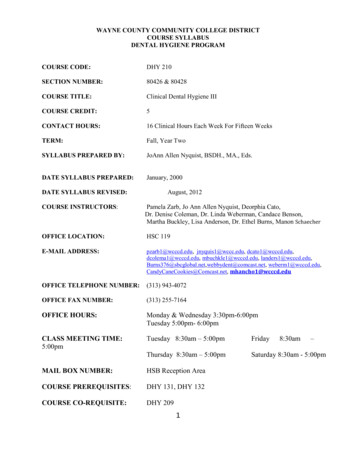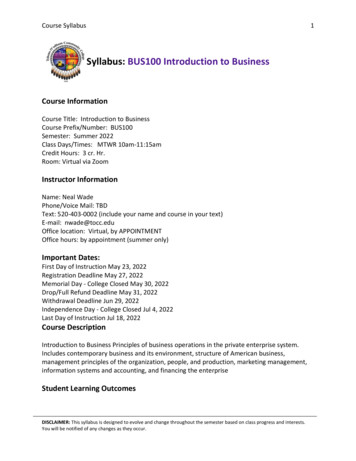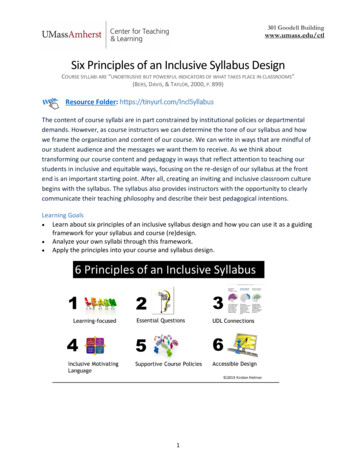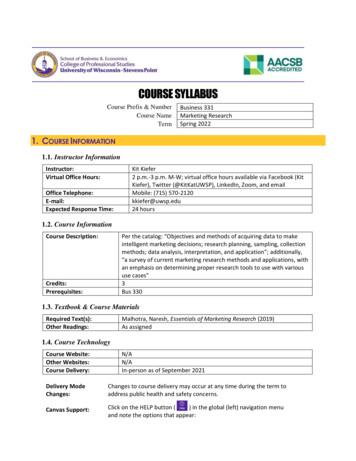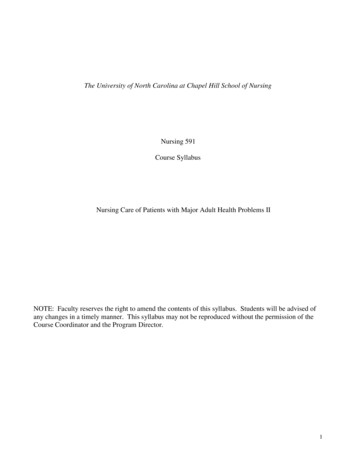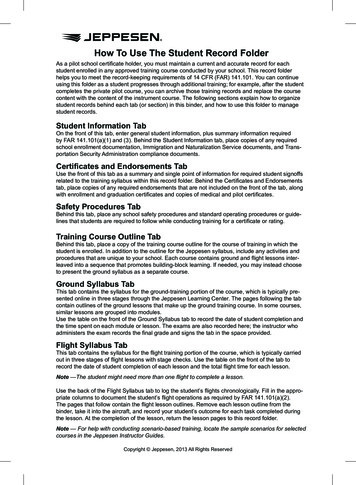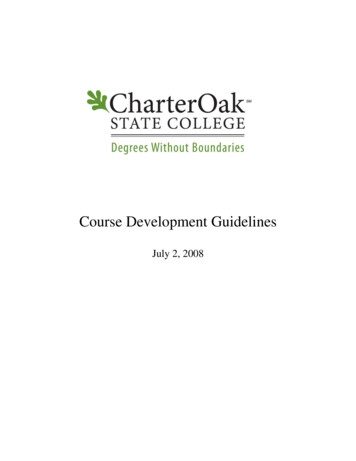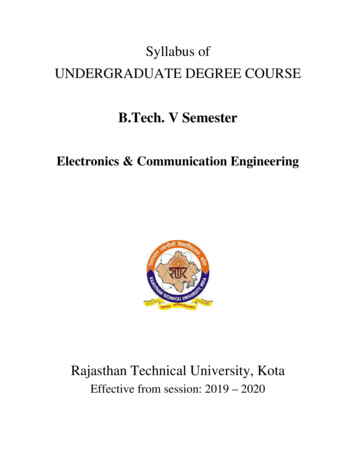
Transcription
Syllabus ofUNDERGRADUATE DEGREE COURSEB.Tech. V SemesterElectronics & Communication EngineeringRajasthan Technical University, KotaEffective from session: 2019 – 2020
RAJASTHAN TECHNICAL UNIVERSITY, KOTASYLLABUSIII Year - V Semester: B.Tech. (Electronics & Communication Engineering)5EC3-01: Computer ArchitectureCredit: 22L 0T 0PSNContentsMax. Marks: 100(IA:20, ETE:80)End Term Exam: 2 HoursHours1Introduction: Objective, scope and outcome of the course.2Basic Structure of Computers, Functional units, software, performanceissues software, machineinstructions and programs, Types ofinstructions, Instruction sets: Instruction formats, Assemblylanguage, Stacks, Ques, Subroutines.Processor organization, Information representation, number formats.Multiplication & division, ALU design, Floating Point arithmetic, IEEE754 floating pointformats3456165Control Design, Instruction sequencing, Interpretation, Hard wiredcontrolDesignmethods, and CPU control unit. oinstructionsize, multiplier control unit. Microprogrammed computers - CPU controlunit6Memory organizations, device characteristics, RAM, ROM, Memorymanagement, Concept ofCache & associative memories, Virtualmemory.5System organization, Input - Output systems, Interrupt, DMA, StandardI/O interfacesConcept of parallel processing, Pipelining, Forms ofparallel processing, interconnect network5TotalSyllabus of 3rd Year B. Tech. (EC) for students admitted in Session 2017-18 onwards28Page 2
RAJASTHAN TECHNICAL UNIVERSITY, KOTASYLLABUSIII Year - V Semester: B.Tech. (Electronics & Communication Engineering)Credit: 33L 0T 0PSN5EC4-02: Electromagnetics WavesMax. Marks: 150(IA:30, ETE:120)End Term Exam: 3 HoursContentsHours1Introduction: Objective, scope and outcome of the course.2Transmission Lines-Equations of Voltage and Current on TX line,Propagation constant and characteristic impedance, and reflectioncoefficient and VSWR, Impedance Transformation on Loss-less and Lowloss Transmission line, Power transfer on TX line, Smith Chart,Admittance Smith Chart, Applications of transmission lines:Impedance Matching, use transmission line sections as circuitelements.Maxwell’s Equations-Basics of Vectors, Vector calculus, Basic laws ofElectromagnetics,Maxwell's Equations, Boundary conditions at MediaInterface.34567010803Uniform Plane Wave-Uniform plane wave, Propagation of wave, Wavepolarization, Poincare’s Sphere, Wave propagation in conductingmedium, phase and group velocity, Power flow and Poynting vector,Surface current and power loss in a conductor.08Plane Waves at a Media Interface-Plane wave in arbitrary direction,Reflection and refraction at dielectric interface, Total internal reflection,wave polarization at media interface, Reflection from a conductingboundary.07Waveguides- Wave propagation in parallel plate waveguide, Analysis ofwaveguide general approach, Rectangular waveguide, Modalpropagation in rectangular waveguide, Surface currents on thewaveguide walls, Field visualization, Attenuation in waveguide.08Radiation-Solution for potential function, Radiation from the Hertzdipole, Power radiated by hertz dipole, Radiation Parameters ofantenna, receiving antenna, Monopole and Dipole antenna07Total42Syllabus of 3rd Year B. Tech. (EC) for students admitted in Session 2017-18 onwardsPage 3
RAJASTHAN TECHNICAL UNIVERSITY, KOTASYLLABUSIII Year - V Semester: B.Tech. (Electronics & Communication Engineering)5EC4-03: Control systemCredit: 33L 0T 0PSNContentsMax. Marks: 150(IA:30, ETE:120)End Term Exam: 3 HoursHours1Introduction: Objective, scope and outcome of the course.2Introduction to control problem- Industrial Control examples. Transferfunction. System with dead-time. System response. Control hardware andtheir models: potentiometers, synchros, LVDT, dc and ac servomotors,tacho-generators, electro hydraulic valves, hydraulicservomotors, electropneumatic valves, pneumatic actuators. Closed-loop systems. Blockdiagram and signal flow graph analysis.Feedback control systems- Stability, steady-state sensitivityandrobustness.proportional, integral and derivative systems. Feedforward and multi-loopcontrol configurations, stability concept, relative stability, Routhstabilitycriterion.34567187Time response of second-order systems- steady-state errors and errorconstants. Performance specifications in time-domain. Root locus methodof design. Lead and lag compensation.6Frequency-response analysis- Polar plots, Bode plot, stability infrequency domain, Nyquistplots. Nyquist stability criterion. Performancespecifications in frequency-domain. Frequency domain methods ofdesign, Compensation & their realization in time & frequency domain.Lead and Lag compensation. Op-amp based and digital implementation ofcompensators. Tuning of process controllers. State variable formulationand solution.8State variable Analysis- Concepts of state, state variable, state model,state modelsfor linearcontinuous time functions, diagonalization oftransfer function, solution of state equations, concept of controllability&observability.6Introduction to Optimal control & Nonlinear control, Optimal Controlproblem, Regulator problem, Output regulator, treking problem.Nonlinear system – Basic concept & analysis.6TotalSyllabus of 3rd Year B. Tech. (EC) for students admitted in Session 2017-18 onwards42Page 4
RAJASTHAN TECHNICAL UNIVERSITY, KOTASYLLABUSIII Year - V Semester: B.Tech. (Electronics & Communication Engineering)5EC4-04: Digital Signal ProcessingCredit: 33L 0T 0PSNContentsMax. Marks: 150(IA:30, ETE:120)End Term Exam: 3 HoursHours1Introduction: Objective, scope and outcome of the course.2Discrete time signals: Sequences; representation of signals on orthogonalbasis; Sampling and reconstruction of signals; Discrete systemsattributes, Z-Transform, Analysis of LSI systems, frequency Analysis,Inverse Systems103Discrete Fourier Transform (DFT), Fast Fourier Transform Algorithm,Implementation of Discrete Time Systems94Design of FIR Digital filters: Window method, Park-McClellan's method.Design of IIR DigitalFilters: Butterworth, Chebyshev and EllipticApproximations; Lowpass, Bandpass, Bandstop and High pass filters.10Effect of finite register length in FIR filter design. Parametric and nonparametric spectral estimation. Introduction to mult-irate signalprocessing. Application of DSP.10Total405Syllabus of 3rd Year B. Tech. (EC) for students admitted in Session 2017-18 onwards1Page 5
RAJASTHAN TECHNICAL UNIVERSITY, KOTASYLLABUSIII Year - V Semester: B.Tech. (Electronics & Communication Engineering)5EC4-05: Microwave Theory & TechniquesCredit: 33L 0T 0PSNContentsMax. Marks: 150(IA:30, ETE:120)End Term Exam: 3 HoursHours1Introduction: Objective, scope and outcome of the course.2Introduction to Microwaves-History of Microwaves, Microwave Frequencybands; Applications of Microwaves: Civil and Military, Medical, EMI/EMC.Mathematical Model of Microwave Transmission-Concept of Mode,Features of TEM, TE and TM Modes, Losses associated with microwavetransmission, Concept of Impedance in Microwave transmission.Analysis of RF and Microwave Transmission Lines-Coaxial line,Rectangularwaveguide, Circular waveguide, Strip line, Micro strip line.Microwave Network Analysis-Equivalent voltages and currents for nonTEMlines, Networkparameters for microwave circuits, ScatteringParameters.Passive and Active Microwave Devices-Microwave passive iodes,Transistors,Oscillators, Mixers.Microwave Semiconductor Devices: Gunn Diodes,IMPATT diodes, Schottky Barrier diodes, PIN diodes.Microwave Tubes:Klystron, TWT, Magnetron.Microwave Design Principles-Impedance transformation, ImpedanceMatching, Microwave Filter Design, RF and Microwave Amplifier Design,Microwave Power Amplifier Design, Low Noise Amplifier Design,Microwave Mixer Design, Microwave Oscillator Design. MicrowaveAntennas- Antenna parameters, Antenna for ground based systems,Antennas for airborne and satellite borne systems, Planar mpedancemeasurement at microwave frequency, Network Analyzer andmeasurement of scattering parameters, Spectrum Analyzerandmeasurement of spectrum of a microwave signal, Noise at microwavefrequency and measurement of noise figure. Measurement of Microwaveantenna parameters.Microwave Systems-Radar, Terrestrial and Satellite Communication,Radio Aidsto Navigation, RFID, GPS. Modern Trends in MicrowavesEngineering- Effect of Microwaves on human body, Medical and ferenceandElectromagnetic Compatibility (EMI & EMC), Monolithic Microwave ICs,RFMEMS for microwave components, Microwave Imaging.Total3456789Syllabus of 3rd Year B. Tech. (EC) for students admitted in Session 2017-18 onwards14544666642Page 6
RAJASTHAN TECHNICAL UNIVERSITY, KOTASYLLABUSIII Year - V Semester: B.Tech. (Electronics & Communication Engineering)5EC5-11: Bio-Medical ElectronicsCredit: 22L 0T 0PSNContentsMax. Marks: 100(IA:20, ETE:80)End Term Exam: 2 HoursHours1Introduction: Objective, scope and outcome of the course.2Brief introduction to human physiology. Biomedical transducers:displacement,velocity, force, acceleration, flow, temperature, potential,dissolved ions and gases.Bio-electrodes and biopotential amplifiers for ECG, EMG, EEG, etc.34Measurement of blood temperature, pressure and flow. Impedanceplethysmography. Ultrasonic, X-ray and nuclear imaging.Prosthesesand aids: pacemakers, defibrillators, heart-lung machine, artificialkidney, aids for the handicapped. Safety aspects.TotalSyllabus of 3rd Year B. Tech. (EC) for students admitted in Session 2017-18 onwards1971128Page 7
RAJASTHAN TECHNICAL UNIVERSITY, KOTASYLLABUSIII Year - V Semester: B.Tech. (Electronics & Communication Engineering)5EC5-12: Embedded SystemsCredit: 22L 0T 0PSNContentsMax. Marks: 100(IA:20, ETE:80)End Term Exam: 2 HoursHours1Introduction: Objective, scope and outcome of the course.12The concept of embedded systems design, Embedded microcontrollercores, embedded memories.53Examples of embedded systems, Technological aspects of embeddedsystems: interfacing between analog and digital blocks, signalconditioning, digital signal processing. Sub system interfacing,interfacing with external systems, user interfacing.Design tradeoffs due to process compatibility, thermal considerations,etc., Software aspects of embedded systems: real time programminglanguages and operating systems for embedded systems.Total4Syllabus of 3rd Year B. Tech. (EC) for students admitted in Session 2017-18 onwards101228Page 8
RAJASTHAN TECHNICAL UNIVERSITY, KOTASYLLABUSIII Year - V Semester: B.Tech. (Electronics & Communication Engineering)5EC5-13: Probability Theory & Stochastic ProcessCredit: 22L 0T 0PSNContentsMax. Marks: 100(IA:20, ETE:80)End Term Exam: 2 HoursHours1Introduction: Objective, scope and outcome of the course.12Sets and set operations; Probability space; Conditional probability andBayes theorem; Combinatorial probability and sampling models.53Discrete random variables, probability mass function, probabilitydistribution function, example random variables and distributions;Continuous random variables, probability density function, probabilitydistribution function, example distributions;Joint distributions, functions of one and two random variables,moments of random variables; Conditional distribution, densities andmoments; Characteristic functions of a random variable; Markov,Chebyshev and Chernoff bounds;456Random sequences and modes of convergence (everywhere, almosteverywhere, probability, distribution and mean square); Limit theorems;Strong and weak laws of large numbers, central limit theoremRandom process. Stationary processes. Mean and covariance functions.Ergodicity. Transmission of random process through LTI. Power spectraldensity.TotalSyllabus of 3rd Year B. Tech. (EC) for students admitted in Session 2017-18 onwards665427Page 9
RAJASTHAN TECHNICAL UNIVERSITY, KOTASYLLABUSIII Year - V Semester: B.Tech. (Electronics & Communication Engineering)5EC5-14: Satellite CommunicationCredit: 22L 0T 0PSNContentsMax. Marks: 100(IA:20, ETE:80)End Term Exam: 2 HoursHours1Introduction: Objective, scope and outcome of the course.12Introduction to Satellite Communication: Principles and architectureof satellite Communication, Brief history of Satellite systems,advantages, disadvantages, applications and frequency bands used forsatellite communication.4Orbital Mechanics: Orbital equations, Kepler's laws, Apogee andPerigee for an elliptical orbit, evaluation of velocity, orbital period,angular velocity etc. of a satellite, concepts of Solar day and Siderealday.4Satellite sub-systems: Study of Architecture and Roles of various subsystems of a satellite system such as Telemetry, tracking, commandand monitoring (TTC & M), Attitude and orbit control system (AOCS),Communication sub-system, power sub-systems etc.5Typical Phenomena in Satellite Communication: Solar Eclipse onsatellite, its effects, remedies for Eclipse, Sun Transit Outagephenomena, its effects and remedies, Doppler frequency shiftphenomena and expression for Doppler shift. Satellite link budget5Flux density and received signal power equations, Calculation ofSystem noise temperature for satellite receiver, noise powercalculation, Drafting of satellite link budget and C/N ratio calculationsin clear air and rainy conditions.4Modulation and Multiple Access Schemes: Various modulationschemes used in satellite communication, Meaning of Multiple Access,Multiple access schemes based on time, frequency, and code sharingnamely TDMA, FDMA and CDMA.434567TotalSyllabus of 3rd Year B. Tech. (EC) for students admitted in Session 2017-18 onwards27Page 10
RAJASTHAN TECHNICAL UNIVERSITY, KOTASYLLABUSIII Year - V Semester: B.Tech. (Electronics & Communication Engineering)5EC4-21: RF Simulation LabCredit: 1.50L 0T 3PSNMax. Marks: 75(IA:45, ETE:30)End Term Exam: 2 HoursContents1Introduction: Objective, scope and outcome of the course.2Study of field pattern of various modes inside a rectangular and circularwaveguide.3Find the change in characteristics impedance and reflection coefficients of thetransmission line by changing the dielectric properties of materials embeddedbetween two conductors.4Design and simulate the following Planar Transmission Lines:I.Strip and micro-strip linesII.Parallel coupled strip lineIII.Coplanar and Slot linesDetermine their field patterns and characteristic impedance.5Design and simulate the following:I.3-dB branch line couplerII.Wilkinson power dividerIII.Hybrid ringIV.Backward wave couplerV.Low pass filtersVI.Band pass filters6Design RF amplifier using microwave BJT.7Design RF amplifier using microwave FET.Syllabus of 3rd Year B. Tech. (EC) for students admitted in Session 2017-18 onwardsPage 11
RAJASTHAN TECHNICAL UNIVERSITY, KOTASYLLABUSIII Year - V Semester: B.Tech. (Electronics & Communication Engineering)5EC4-22: Digital Signal Processing LabCredit: 1.50L 0T 3PSNMax. Marks: 75(IA:45, ETE:30)End Term Exam: 2 HoursContents1Introduction: Objective, scope and outcome of the course.2Generation of continuous and discrete elementary signals (impulse,unitstep,ramp) using mathematical expression.3Perform basic operations on signals like adding, subtracting, shifting andscaling.4Perform continuous and discrete time Convolution (using basic definition).5Checking Linearity and Time variance property of a system using convolution,shifting.6To generate and verify random sequences with arbitrary distributions, meansand variances forfollowing:(a) Rayleigh distribution(b) Normal distributions: N(0,1).(c) Gaussion distributions: N (m, x)(d) Random binary wave.7To find DFT / IDFT of given DT signal.8N-point FFT algorithm.9To implement Circular convolution.10MATLAB code for implementing z-transform and inverse z-transform.11Perform inverse z-transform using residuez MATLAB function.12MATLAB program to find frequency response of analog LP/HP filters.13To design FIR filter (LP/HP) using windowing (rectangular, triangular, Kaiser)technique using simulink.Syllabus of 3rd Year B. Tech. (EC) for students admitted in Session 2017-18 onwardsPage 12
RAJASTHAN TECHNICAL UNIVERSITY, KOTASYLLABUSIII Year - V Semester: B.Tech. (Electronics & Communication Engineering)5EC4-23: Microwave LabCredit: 10L 0T 2PSNMax. Marks: 50(IA:30, ETE:20)End Term Exam: 2 HoursContents1Introduction: Objective, scope and outcome of the course.2Study of various microwave components and instrumentsfrequency meter, attenuator, detector and VSWR meter.like(a) Measurement of guide wavelength and frequency using a X-bandslotted line setup.(b) Measurement of low and high VSWR using a X-band slotted line setup.3Introduction to Smith chart, measurement of SWR, shift in minimumstanding wave with unknown load and calculation of unknown loadimpedance using Smith chart.4Study the behavior of terminated coaxial transmission lines in time andfrequency domain.5(a) Draw the V-I characteristics of a Gunn diode and determine theoutput power and frequency as a function of voltage.(b) Study the square wave modulation of microwave signal using PIN diode.6Study the square wave modulation of microwave signal using PINdiode.Study and measure the power division and isolationcharacteristics of a microstrip 3dB power divider.7Study of rat race hybrid ring (equivalent of waveguide Magic-Tee ) inmicro-strip.8(a) To study the characteristics of micro-strip 3dB branch linecoupler, strip line backward wave coupler as a function offrequency and compare their bandwidth.(b) (b)Measure the microwave input, direct, coupled and isolatedpowers of a backward wave strip line coupler at the centrefrequency using a power meter. From the measurementscalculate the coupling, isolation and directivity of the coupler.Syllabus of 3rd Year B. Tech. (EC) for students admitted in Session 2017-18 onwardsPage 13
Syllabus ofUNDERGRADUATE DEGREE COURSEB.Tech. VI SemesterElectronics & Communication EngineeringRajasthan Technical University, KotaEffective from session: 2019-20
RAJASTHAN TECHNICAL UNIVERSITY, KOTASYLLABUSIII Year - VI Semester: B.Tech. (Electronics & Communication Engineering)6EC3-01: Power ElectronicsCredit: 22L 0T 0PSNContentsMax. Marks: 100(IA:20, ETE:80)End Term Exam: 2 HoursHours1Introduction: Objective, scope and outcome of the siccharacteristics &working of Power Diodes, Diac, Triac, MOSFETs, IGBT,GTO, Power Transistor and SCR- Principle of operation, V-ICharacteristics, Turn-On mechanism and its applications6CONVERTERS: Basic concept, Working Principles of Single phase halfWave bridge converter, Single Phase Full Bridge Converter, 3 PhaseBridge Converter54INVERTERS: Voltage Source Inverter, Current Source Inverter, PWMControl of Voltage Source Converter and applications.55INDUSTRIAL POWER SUPPLIES: Principle of operation of choppers. Stepup, Step down and reversible choppers. Chopper control techniques,High frequency electronic ballast, Switch Mode Power Supply: Fly backconverter, forward/buck converter, Boost converter and buck-boostconverter. Uninterruptible Power Supply.6MOTOR CONTROL: Introduction to speed control of DC motors usingphase controlled converters and choppers, Basic idea of speed control ofthree phase induction motors using voltage and frequency controlmethods.536TotalSyllabus of 3rd Year B. Tech. (EC) for students admitted in Session 2017-18 onwards28Page 2
RAJASTHAN TECHNICAL UNIVERSITY, KOTASYLLABUSIII Year - VI Semester: B.Tech. (Electronics & Communication Engineering)6EC4-02: Computer NetworkCredit: 33L 0T 0PSNContentsMax. Marks: 150(IA:30, ETE:120)End Term Exam: 3 HoursHours1Introduction: Objective, scope and outcome of the course.12Queuing Theory- Pure birth, Pure death & Birth-death processes,Mathematical models for M/M/1, M/M/ , M/M/m, M/M/1/K andM/M/m/m queues. Little’s formula.7Introduction to computer networks and the Internet: Application layer:Principles of network applications, The Web and Hyper Text TransferProtocol, File transfer, Electronic ail, Domain name system, Peer-to-Peerfile sharing, Socket programming, Layering concepts. Packet switching,Blocking in packet switches, Three generations of packet switches,switch fabric, Buffering, Multicasting, Statistical Multiplexing.9Transport layer: Connectionless transport - User Datagram Protocol,Connection oriented transport – Transmission Control Protocol, RemoteProcedure Call. Congestion Control and Resource Allocation: Issues inResource Allocation, Queuing Disciplines, TCP congestion Control,Congestion Avoidance Mechanisms and Quality of Service.95Network layer: Virtual circuit and Datagram networks, Router, InternetProtocol, Routing algorithms, Broadcast and Multicast routing76Link layer: ALOHA, Multiple access protocols, IEEE 802 standards, LocalArea Networks, addressing, Ethernet, Hubs, Switches.Fundamental ofSDN, Open flow.734TotalSyllabus of 3rd Year B. Tech. (EC) for students admitted in Session 2017-18 onwards40Page 3
RAJASTHAN TECHNICAL UNIVERSITY, KOTASYLLABUSIII Year - VI Semester: B.Tech. (Electronics & Communication Engineering)6EC4-03: Fiber Optics CommunicationsCredit: 33L 0T 0PSNContentsMax. Marks: 150(IA:30, ETE:120)End Term Exam: 3 HoursHours1Introduction: Objective, scope and outcome of the course.12Introduction to vector nature of light, propagation of light, propagation oflight in a cylindricaldielectric rod, Ray model, wave model.Different typesof optical fibers, Modal analysis of a step index fiber.83Signal degradation on optical fiber due to dispersion and attenuation.Fabrication of fibers andmeasurement techniques like OTDR74Optical sources - LEDs and Lasers, Photo-detectors - pin-diodes, APDs,detectorresponsivity, noise, optical receivers. Optical link design - BERcalculation, quantum limit, power penalties.85Optical switches - coupled mode analysis of directional couplers, electrooptic switches.Optical amplifiers - EDFA, Raman amplifier.86WDM and DWDM systems. Principles of WDM networks.Nonlineareffects in fiber optic links. Concept of self-phase modulation,groupvelocity dispersion and solition based communication.8TotalSyllabus of 3rd Year B. Tech. (EC) for students admitted in Session 2017-18 onwards40Page 4
RAJASTHAN TECHNICAL UNIVERSITY, KOTASYLLABUSIII Year - VI Semester: B.Tech. (Electronics & Communication Engineering)6EC4-04: Antennas and PropagationCredit: 33L 0T 0PSNContentsMax. Marks: 150(IA:30, ETE:120)End Term Exam: 3 HoursHours1Introduction: Objective, scope and outcome of the course.12Fundamental Concepts-Physical concept of radiation, Radiation pattern,near andfar-field regions, reciprocity, directivity and gain, effectiveaperture, polarization, input impedance, efficiency, Friis transmissionequation, radiation integrals and auxiliary potential functions.7Radiation from Wires and Loops-Infinitesimal dipole, finite-length dipole,linear elements near conductors, dipoles for mobile communication,small circular loop.6Aperture and Reflector Antennas-Huygens' principle, radiation fromrectangular and circular apertures, design considerations, Babinet'sprinciple, Radiation from sectoral and pyramidal horns, design concepts,prime-focus parabolic reflector and cassegrain antennas.75Broadband Antennas-Log-periodic and Yagi-Uda antennas, frequencyindependent antennas, broadcast antennas.56Micro strip Antennas-Basic characteristics of micro strip antennas,feeding methods, methods of analysis, design of rectangular and circularpatch antennas.6Antenna Arrays-Analysis of uniformly spaced arrays with uniform andnon-uniform excitation amplitudes, extension to planar arrays,synthesis of antenna arrays using Schelkun off polynomial method,Woodward-Lawson method.58Basic Concepts of Smart Antennas-Concept and benefits of smartantennas, fixed weight beamforming basics, Adaptive beam forming.49Different modes of Radio Wave propagation used in current practice.1347TotalSyllabus of 3rd Year B. Tech. (EC) for students admitted in Session 2017-18 onwards42Page 5
RAJASTHAN TECHNICAL UNIVERSITY, KOTASYLLABUSIII Year - VI Semester: B.Tech. (Electronics & Communication Engineering)6EC4-05: Information Theory and CodingCredit: 33L 0T 0PSNContentsMax. Marks: 150(IA:30, ETE:120)End Term Exam: 3 HoursHours1Introduction: Objective, scope and outcome of the course.012Basics of information theory, entropy for discrete ensembles; Shannon'snoiseless coding theorem; Encoding of discrete sources.153Markov sources; Shannon's noisy coding theorem and converse fordiscrete channels; Calculation of channel capacity and bounds fordiscrete channels; Application to continuous channels.15Techniques of coding and decoding; Huffman codes and uniquelydetectable codes; Cyclic codes, convolutional arithmetic codes.10Total414Syllabus of 3rd Year B. Tech. (EC) for students admitted in Session 2017-18 onwardsPage 6
RAJASTHAN TECHNICAL UNIVERSITY, KOTASYLLABUSIII Year - VI Semester: B.Tech. (Electronics & Communication Engineering)6EC5-11: Introduction to MEMSCredit: 33L 0T 0PSNContentsMax. Marks: 150(IA:30, ETE:120)End Term Exam: 3 HoursHours1Introduction: Objective, scope and outcome of the course.12Introduction and Historical Background.13Mechanics of solids in MEMS/NEMS: Stresses, Strain, Hookes’s law,Poisson effect, Linear Thermal Expansion, Bending; Energy methods,Overview of Finite Element Method, Modeling of CoupledElectromechanical Systems.14Scaling Effects. Micro/Nano Sensors, Actuators and Systems overview:Case studies. Review of Basic MEMS fabrication modules: Oxidation,Deposition Techniques, Lithography (LIGA), and Etching.14Micromachining: Surface Micromachining, sacrificial layer processes,Stiction; Bulk Micromachining, Isotropic Etching and AnisotropicEtching, Wafer Bonding.10Total4045Syllabus of 3rd Year B. Tech. (EC) for students admitted in Session 2017-18 onwardsPage 7
RAJASTHAN TECHNICAL UNIVERSITY, KOTASYLLABUSIII Year - VI Semester: B.Tech. (Electronics & Communication Engineering)6EC5-12: Nano ElectronicsCredit: 33L 0T 0PSNContentsMax. Marks: 150(IA:30, ETE:120)End Term Exam: 3 HoursHours1Introduction: Objective, scope and outcome of the course.012Introduction to nanotechnology, meso structures, Basics of QuantumMechanics: Schrodinger equation, Density of States. Particle in a boxConcepts, Degeneracy. Band Theory of Solids. Kronig-Penny Model.Brillouin Zones.15Shrink-down approaches: Introduction, CMOS Scaling, The nano scaleMOSFET, Finfets, Vertical MOSFETs, limits to scaling, systemintegration limits (interconnect issues etc.).10Resonant Tunneling Diode, Coulomb dots, Quantum blockade, Singleelectron transistors,Carbon nanotube electronics, Bandstructure andtransport, devices, applications, 2D semiconductors and electronicdevices, Graphene, atomistic simulation14Total4034Syllabus of 3rd Year B. Tech. (EC) for students admitted in Session 2017-18 onwardsPage 8
RAJASTHAN TECHNICAL UNIVERSITY, KOTASYLLABUSIII Year - VI Semester: B.Tech. (Electronics & Communication Engineering)6EC5-13: Neural Network And Fuzzy Logic ControlCredit: 3Max. Marks: 150(IA:30, ETE:120)3L 0T 0PEnd Term Exam: 3 HoursSNContentsHours1Introduction: Objective, scope and outcome of the course.12NEUROPHYSIOLOGY: Introduction: Elementary neurophysiology –From neurons to ANNs - Neuron model McCulloch-Pitts model, HebbianHypothesis; limitations of single-layered neural networks.Applications Of8Neural Networks: Pattern classification, Associative memories,Optimization, Applications in Image Processing-Iris, finger print & face,Applications in decision making.3THE PERCEPTRON: The Perceptron and its learning law. Classificationof linearly separable patterns. Linear Networks: Adaline - the adaptivelinear element. Linear regression. The Wiener-Hopf equation. The LeastMean-Square (Widrow-Hoff) learning algorithm. Method of steepestdescent. Adaline as a linear adaptive filter. A sequential regression9algorithm.Multi-Layer Feedforward Neural Networks: Multi-LayerPerceptrons. Supervised Learning. Approximation and interpolation offunctions. Back-Propagation Learning law. Fast training algorithms.Applications of multilayer perceptrons: Image coding, Paint-qualityinspection, Nettalk.4FUZZY LOGIC: Introduction -Uncertainty & precision, Statistics andrandom process, Uncertainty in information, Fuzzy sets andmembership. Membership Functions: Features of membership function.7Standard forms and boundaries, Fuzzification, Membership valueassignment – Intuition, Inference, Neural networks. Fuzzy To CrispConversions: Maximum membership principle.5DEFUZZIFICATION METHODS- Centroid method, Weighted averagemethod, Meanmax membership. Fuzzy Rule Based Systems: Naturallanguage, linguistic hedges, Rule based system –Canonical rule forms,8Decomposition of compound rules, Likelihood and truth qualificationAggregation of Fuzzy rules. Graphical techniques of reference.6FUZZY CONTROL SYSTEM- Simple Fuzzy Logic controller, General FLC,Control System Design Problem Control (Decision) Surface, Assumptionsin a Fuzzy Control System Design, Special forms of FLC system models,Industrial application: Aircraft Landing Control Problem.Fuzzy9Engineering Process Control: Classical Feedback Control, Classical PIDControl, Multi-input, Multi-output (MIMO) Control Systems, FuzzyStatistical Process ControlTotal42Syllabus of 3rd Year B. Tech. (EC) for students admitted in Session 2017-18 onwardsPage 9
RAJASTHAN TECHNICAL UNIVERSITY, KOTASYLLABUSIII Year - VI Semester: B.Tech. (Electronics & Communication Engineering)6EC5-14: High Speed ElectronicsCredit: 33L 0T 0PSNContentsMax. Marks: 150(IA:30, ETE:120)End Term Exam: 3 HoursHours1Introduction: Objective, scope and outcome of the course.12Transmission line theory (basics) crosstalk and nonideal effects; signalintegrity: impact ofpackages, vias, traces, connectors; non
5 Typical Phenomena in Satellite Communication: Solar Eclipse on satellite, its effects, remedies for Eclipse, Sun Transit Outage phenomena, its effects and remedies, Doppler frequency shift phenomena and expression for Doppler shift. Satellite link budget 5 6 Flux density and received signal power equations, Calculation of





